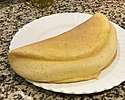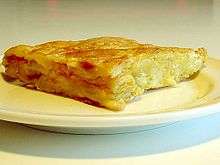Omelette
In cuisine, an omelette or omelet is a dish made from beaten eggs, fried with butter or oil in a frying pan (without stirring as in scrambled egg). It is quite common for the omelette to be folded around fillings such as cheese, chives, vegetables, mushrooms, meat (often ham or bacon), or some combination of the above. Whole eggs or egg whites are often beaten with a small amount of milk, cream, or water.
 Blond unbrowned omelette with mushrooms and herbs | |
| Alternative names | Omelet |
|---|---|
| Course | Breakfast, brunch |
| Place of origin | Ancient Iran[1][2] |
| Serving temperature | Hot |
| Main ingredients | Eggs, butter or oil |
History
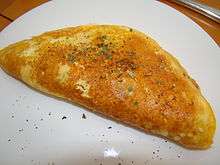
The earliest omelettes are believed to have originated in ancient Persia.[1][2]:65 According to Breakfast: A History, they were "nearly indistinguishable" from the Iranian dish kookoo sabzi.[2]
According to Alan Davidson,[1] the French word omelette (French: [ɔm.lɛt]) came into use during the mid-16th century, but the versions alumelle and alumete are employed by the Ménagier de Paris (II, 5) in 1393.[3] Rabelais (Pantagruel, IV, 9) mentions an homelaicte d'oeufs,[4] Olivier de Serres an amelette, François Pierre La Varenne's Le cuisinier françois (1651) has aumelette, and the modern omelette appears in Cuisine bourgeoise (1784).[5]
According to the founding legend of the annual giant Easter omelette of Bessières, Haute-Garonne, when Napoleon Bonaparte and his army were traveling through southern France, they decided to rest for the night near the town of Bessières. Napoleon feasted on an omelette prepared by a local innkeeper, and thought it was a culinary delight. He then ordered the townspeople to gather all the eggs in the village and to prepare a huge omelette for his army the next day.[6]
Alexander Dumas discusses several variations of omelet in his Grand dictionnaire de cuisine. One is an omelet with fresh herbs (parsley, chives and tarragon, another is a variation with mushrooms that Dumas says may be adapted using green peas, asparagus, spinach, sorrel or varieties of truffles. The "kirsch omelet" (or rum omelet) is a sweet omelet made with sugar and liquor, either kirsh or rum. The omelet is rolled and sprinkled with powdered sugar. A hot poker is used to burn a design into the omelet and it is served with a sweet sauce made of liquor and apricot jam. Another sweet omelet, attributed to a royal cook of Prussia, is made with apples and brown sugar glaze. Of the Arabian omelet, Dumas writes "I have been concerned in this book to give the recipes of peoples who have no true cuisine. Here, for example, is a recipe the Bey's cook was good enough to give me." The omelet itself is made with an ostrich egg and served with a spicy tomato-pepper sauce.[7]
Variations by country
| Nutritional value per 100 g (3.5 oz) | |
|---|---|
| Energy | 657 kJ (157 kcal) |
0.7 g | |
12 g | |
10.6 g | |
| Vitamins | Quantity %DV† |
| Vitamin A equiv. | 22% 172 μg |
| Thiamine (B1) | 9% 0.1 mg |
| Riboflavin (B2) | 33% 0.4 mg |
| Niacin (B3) | 1% 0.1 mg |
| Pantothenic acid (B5) | 24% 1.2 mg |
| Vitamin B6 | 8% 0.1 mg |
| Folate (B9) | 10% 39 μg |
| Vitamin B12 | 46% 1.1 μg |
| Choline | 43% 212 mg |
| Vitamin D | 5% 29 IU |
| Vitamin E | 8% 1.2 mg |
| Vitamin K | 4% 4.5 μg |
| Minerals | Quantity %DV† |
| Calcium | 5% 47 mg |
| Iron | 12% 1.5 mg |
| Magnesium | 3% 10 mg |
| Phosphorus | 23% 162 mg |
| Potassium | 2% 114 mg |
| Selenium | 38% 26.7 μg |
| Sodium | 11% 161 mg |
| Zinc | 9% 0.9 mg |
| Other constituents | Quantity |
| Water | 75.9 g |
| Cholesterol | 356 mg |
| |
| †Percentages are roughly approximated using US recommendations for adults. Source: USDA Nutrient Database | |
China
- Egg foo yung, a Cantonese omelette made with beaten eggs and usually ham[8]
- An oyster omelette, a dish of Hokkien and Teochew origin made with oysters, starch and egg batter
France
- Depending on sources, a standard omelette is cooked in butter on medium (or sometimes high[9]) heat,[10] is supposed to be golden brown[9] or "unbrowned or very lightly browned"[10] on the outside and soft in the inside[9] (though variations are possible according to preferences[10]); according to some American cookbooks reflecting high-end restaurant practices, a "French Omelette" should be unbrowned, cooked slowly over medium-low to medium heat, with initial stirring to prevent curds and sticking.[11] Good with just salt and pepper, this omelette is often flavored with tomato and finely chopped herbs (often fines herbes[12] or tarragon, chervil, parsley and chives) or chopped onions.
- The Omelette de la mère Poulard, a Norman specialty first developed in Mont-Saint-Michel, has been called the most famous omelette in the world. It is served without fillings but often served with heavy garnishes.[13]
India
- Egg Appam is an omelette made with fermented rice batter and coconut milk, an egg is broken into the batter as it cooks.
- In Parsi cuisine, Pora is an omelette made from eggs, onion, tomato, green chillies, and coriander leaves.[14][15] It is usually served for breakfast with Indian/Irani tea and bread.
Indonesia
- In Betawi cuisine, kerak telor is a traditional spicy omelette that made from glutinous rice cooked with egg and served with serundeng (fried shredded coconut), fried shallots and dried shrimp as topping.
- Fuyunghai or puyonghai is a Chinese Indonesian omelette, usually made from the mixture of vegetables such as carrots, bean sprouts, and cabbages, mixed with meats such as crab, shrimp, or minced chicken.
Iran
Italy
Japan
- In Japan, tamagoyaki is a traditional omelette in which eggs are beaten with mirin, soy sauce, bonito flakes, sugar and water, and cooked in a special rectangular frying pan. The omelette is cooked by frying a thin layer of egg mixture and then rolling it up quickly with a pair of chopsticks to form a sausage shape in one end of the pan. Another thin layer of egg is then added to the bottom of the pan and is again rolled, with the original rolled, cooked egg at the centre, over to the other end of the pan. This is repeated until all the egg has been used up, resulting in a dense cylindrical omelette containing many thin layers. This is then squeezed into a rectangular or circular cross-section using a sushi mat, and sliced into segments for serving. Omelette (pronounced omuretsu) can mean a Western omelette.
- Omurice (from the English words "omelette" and "rice") is an omelette filled with rice and usually served with a large amount of tomato ketchup. Omu-soba is an omelette with yakisoba as its filling.
- Tenshindon is a Japanese-Chinese specialty, consisting of a crab meat omelette on rice.[18]
Korea
In the Korean cuisine, traditional omelettes are known as Gyeran-mari (계란말이, "rolled-eggs") which is a type of savory banchan. Gyeran-mari is made with beaten eggs, mixed with finely diced vegetables, meats, and seafood. This side dish is often found in most Korean banquet (Janchi) meals, as well as Korean fast food (Bunsik) restaurants.
Philippines
In the Philippines, omelettes are usually known as torta, they include:
- Tortang dulong or maranay - an omelette, usually crispy, made with tiny fish from the family Salangidae known as dulong in Tagalog and ipon, libgao, or maranay in Visayan.[19][20][21][22] It is sometimes called okoy, though traditional okoy is not an omelette, but rather a type of fritter made with glutinous rice.
- Tortang giniling or tortang picadillo - an omelette with ground meat (usually beef or pork) and sautéed vegetables.[23]
- Tortang gulay - an omelette with peppers, mushrooms, onion, and garlic.
- Tortang kalabasa - an omelette made with finely julienned calabaza, eggs, flour, and salt.[24]
- Tortang kamote - an omelette made with mashed sweet potato, eggs, flour, and salt.
- Tortang talong - an eggplant fritter.[25]
Spain
- The Spanish tortilla de patatas, or tortilla española in other Spanish-speaking countries, is a traditional and very popular thick omelette containing sliced potatoes sautéed in cooking oil. It often includes sliced onions (tortilla de patata con cebolla) and less commonly other additional fillings, such as cheese, bell peppers, and cooked diced ham.
Thailand
- In Thai cuisine, a traditional omelette is called khai chiao ไข่เจียว (khai meaning "egg", and chiao meaning oil-fried), in which the beaten egg mixture and a small quantity of fish sauce is deep fried in a wok filled with 1-2 cups of vegetable oil and served over steamed rice. The dish is usually served with Sriracha sauce and cilantro. A variation on this dish is khai chiao songkhrueang, where the plain egg omelette is served together with a stir-fry of meat and vegetables. Yet another type of Thai omelette is khai yat sai, literally "eggs filled with stuffing".[26]
United States
- A Denver omelette, also known as a Southwest omelette or Western omelette,[27] is an omelette filled with diced ham, onions, and green bell peppers,[28] though there are many variations on fillings. Often served in the Southwestern United States, this omelette sometimes has a topping of cheese and a side dish of hash browns or fried potatoes.[29]
- A Hangtown fry, containing bacon and breaded oysters, is an unusual omelette that originated in Placerville, California, during the gold rush.
- An egg white omelette is a variation which omits the yolks to remove fat and cholesterol,[30] which reside exclusively in the yolk portion of an egg.
Mesoamerica
While the Spanish term tortilla in Spain and the Philippines is applied to an omelette dish, in Mesoamerica it is a surrogate term for a flatbread made of wheat or corn. An omelette in Mesoamerica is commonly termed as tortilla de huevos, and more colloquially, omleta.
Gallery
.jpg) Omellet containing large amounts of chopped herbs.
Omellet containing large amounts of chopped herbs. A browned omelet
A browned omelet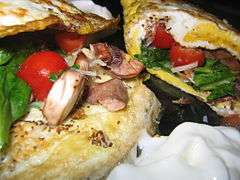 An omelette foldover
An omelette foldover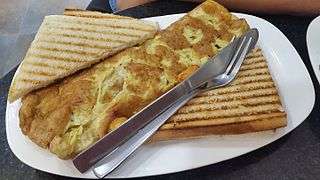 Masala omelette with bread toasties
Masala omelette with bread toasties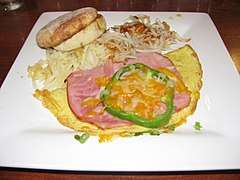 Denver omelette served with hash browns and English muffin
Denver omelette served with hash browns and English muffin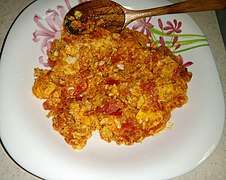 Iranian omelette with tomato
Iranian omelette with tomato Tamagoyaki, a Japanese omelette
Tamagoyaki, a Japanese omelette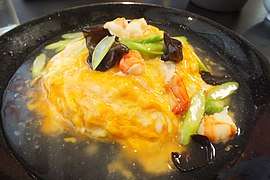
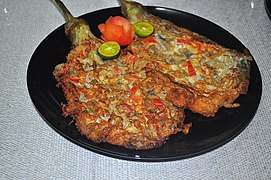 Tortang talong, a Filipino omelette made with grilled eggplant
Tortang talong, a Filipino omelette made with grilled eggplant
Records
On March 19, 1994, the largest omelette (128.5 m2, 1,383 sq ft) in the world at the time was made with 160,000 eggs in Yokohama, Japan,[31] but was subsequently overtaken by another, weighing 2,950 kilograms (6,500 lb), made by the Canadian Lung Association at the Brockville Memorial Centre in Brockville, Ontario, Canada, on May 11, 2002.[32] In turn, that record was surpassed on August 11, 2012, by an omelette cooked by the Ferreira do Zêzere City Council in Santarém, Portugal. This record-breaking omelette weighed 6,466 kg (14,255 lb), and required 145,000 eggs and a 10.3-metre (34 ft) diameter pan.[33]
See also
References
- Davidson, Alan (2014-08-21). The Oxford Companion to Food. OUP Oxford. p. 571. ISBN 9780191040726.
- Anderson, Heather Arndt (2013-07-11). Breakfast: A History. AltaMira Press. p. 65. ISBN 9780759121652.
- "Omelette"
- "En pareille alliance, l'un appeloit une sienne, mon homelaicte. Elle le nommoit mon oeuf, et estoient alliés comme une homelaicte d'oeufs".
- Three noted by Maguelonne Toussaint-Samat, (Anthea Bell, tr.) A History of Food, revised ed, 2009, p. 326; de Serres note "Le glossaire accadien"
- "Napoleon and the Omelette". Eggy Guru. Retrieved 2019-02-22.
- Alexandre Dumas' Dictionary of Cuisine, 1873
- Egg Foo Yung
- Ginette Mathiot (éd), La Cuisine pour tous, 1955, p.107 : "(...) laissez cuire à feu vif. L'omelette doit être dorée à l'extérieur, baveuse au centre."
- Terese Allen (1991). The Ovens of Brittany Cookbook. The Guest Cottage, Inc. pp. 79–. ISBN 978-0-942495-11-9.
- "How to Perfect the French Omelet (Hint: There Will Be Butter)". Bon Appétit. March 27, 2017. Retrieved 2019-06-27.
- Julia Child, Bertholle, L., Beck, S., Mastering the Art of French Cooking (Vol. I), page 135, Knopf, 1961
- Cloake, Felicity (June 4, 2019). "Bon appétit! How I rediscovered the joys of French cuisine". The Guardian. ISSN 0261-3077. Retrieved October 2, 2019.
- "Parsi Pora, Omelette Parsi Food Style". www.nilouferskitchen.com. Retrieved 2018-04-28.
- King, Niloufer Ichaporia (2007-06-18). My Bombay Kitchen: Traditional and Modern Parsi Home Cooking. University of California Press. ISBN 9780520933378.
- "آشنایی با روش تهیه نرگسی؛ غذای رژیمی". Hamshahri newspaper. Retrieved 19 September 2013.
- "SPINACH OMELETTE". Retrieved 19 September 2013.
- Itoh, Makiko (September 14, 2019). "Tenshinhan: A made-in-Japan omelette with Chinese influences". The Japan Times. Retrieved October 6, 2019.
- "Tortang Dulong Recipe". Panlasang Pinoy. Retrieved 9 June 2020.
- "Dulong Omelet Recipe (Tortang Dulong)". Yummy.ph. Retrieved 9 June 2020.
- "15 Filipino Foods I Bet You Haven't Tried in the Philippines!". BecomingFilipino. Retrieved 9 June 2020.
- "Small Fish with Beady Eyes…". Market Manila. Retrieved 9 June 2020.
- Merano, Manjo. "Tortang Giniling Recipe". Pansalang Pinoy. Pansalang Pinoy. Retrieved 12 February 2015.
- "Tortang Kalabasa with Malunggay". Mama's Guide Recipes. Retrieved 10 July 2019.
- "Tortang Talong Recipe". Pilipinas Recipes. Pilipinas Recipes. Retrieved 27 October 2018.
- "Kai Yat Sai Talay (Thai Omelette With Seafood) Recipe". Food.com. March 4, 2008. Retrieved October 6, 2019.
- Ayto, J. (2012). The Diner's Dictionary: Word Origins of Food and Drink. Oxford Quick reference collection. OUP Oxford. p. 115. ISBN 978-0-19-964024-9. Retrieved October 6, 2019.
- of, S.T.; Oseland, J. (2014). Saveur: The New Classics Cookbook: More Than 1,000 of the World's Best Recipes for Today's Kitchen. Weldon Owen. p. 124. ISBN 978-1-61628-735-1. Retrieved October 6, 2019.
- "Denver Omelette Scrambler". Archived from the original on 2011-07-16. Retrieved 2010-12-30.
- Brewer, S.; Siple, M. (2011). Low-Cholesterol Cookbook For Dummies. Wiley. p. pt94. ISBN 978-1-119-99679-8. Retrieved October 6, 2019.
- Guinness Book of World Records 2001. ISBN 0-85112-102-0.
- "Largest Omelette". Guinness World Records. Retrieved 2007-06-15.
- "Largest Omelette". Guinness World Records. Retrieved 2014-07-16.
External links
| Wikibooks Cookbook has a recipe/module on |
| Wikimedia Commons has media related to Omelettes. |
| Look up omelette in Wiktionary, the free dictionary. |
